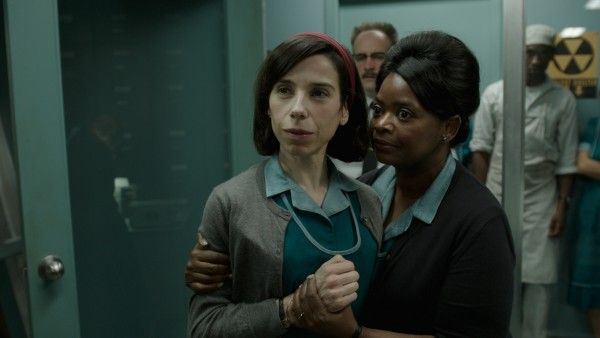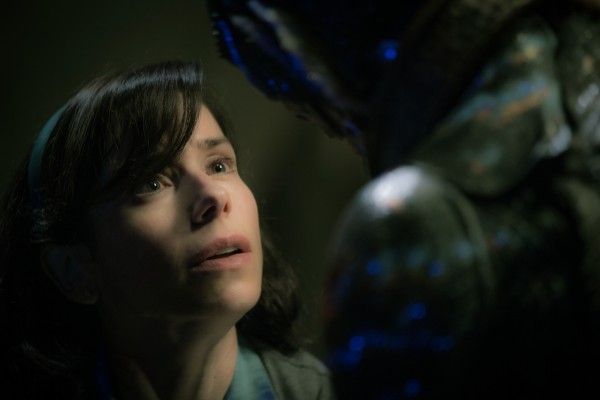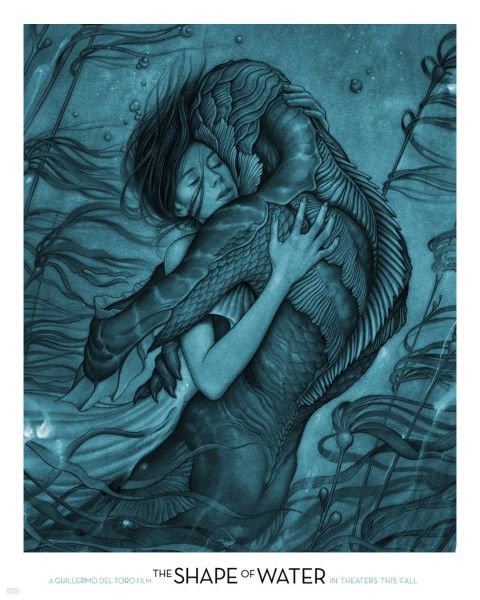Shape of Water Bad Review Funny
[This is a re-post of ourShape of Waterreview from the 2017 Venice Film Festival. The movie opens in limited release on December 1st.]
Guillermo del Toro's newest film, The Shape of Water , has a mute protagonist, a Cold War backdrop, and an aquatic creature that has spots on his skin that glows like a map of the universe. It's also a love story. It's perhaps his most ambitious film because combining those elements plus a narrative weave of non-verbal communication—or the faultiness of relying on words—is extremely difficult even before I tell you that the love story is between a woman and a creature. As such, it's an immense achievement because The Shape of Water not only entertains as a sumptuous fairytale, but it reinforces a faith in humanity set in a time where tolerance of other races, nationalities, and non-"family values" love was volatile. Much like it feels like that time period of intolerance is percolating back to the surface now. This is del Toro's Beauty and the Beast with the delicate time period touches and social awareness of Far from Heaven .
Set in 1950's Baltimore, The Shape of Water opens in a flooded apartment that rests above a movie theater. There are two apartments above the theater, one belonging to Elisa (Sally Hawkins), a mute woman who works as a janitor at a high-clearance research facility, the other belongs to her friend Giles (Richard Jenkins), a homosexual editorial painter who's lost his standing at an advertising firm. The theater below is decorated almost like a cathedral, as old theaters were. Eventually this film reveals a creature and it'd be easy for del Toro to show 1950's creature features in the theater but instead the glimpses we get into the theater show biblical epics.
This ends up being a nice touch by del Toro because cinema has always served as a refuge for the "freaks" of the world, even if entertainment hasn't always included them. And every person who assists in breaking out the creature from the laboratory is in different ways someone who's been marginalized by society. Whether it's the less employable mute woman, her gay friend, her black co-worker, Zelda (Octavia Spencer), or the scientist spy, Dmitri (Michael Stuhlbarg), who goes against the orders of the Kremlin to destroy it before the American military can learn from it (because national wars impeding research of a creature we could learn from goes against science, which knows no borders or nationalities). Those impeding them are the military of the governments on each side, governments that also suppress open homosexuality and allow business to enforce discrimination against people of color.
(The escape is midway through the film, I'm purposefully leaving all the surprises after unmentioned in this review, but it's the escape onward that truly makes this film magnificent and where all the elements come together.)

The creature (played by Doug Jones) looks a little like the finned man in the 1950's B-movie The Creature from the Black Lagoon , except with far better technology that animates a protective layer over his eyes, his fins, hands, and spots that glow. He was discovered in the Amazon by Colonel Strickland (Michael Shannon), a man not interested in science; he's dismissive of the "primitives" who worshipped the creature as a God.
Strickland carries a Taser stick, which he uses to electrocute the creature into submission. The military might want to see if this creature could be sent to space before a human, a la Laika, the dog that the Russians launched into space before the Americans got a man on the moon. Or they might just dissect it, a la Roswell, if you believe in that project. And Strickland is there to enforce the will of whatever the military chooses to do.
We're introduced to Elisa during her daily ritual of making hard-boiled eggs for her lunch, masturbating in the tub, conversing with Giles via sign language and TV watching, and arriving late to work—with Zelda punching her time clock so she's clocked in on time. Zelda and Giles are warm and friendly with Elisa, and they do know sign language, but you get the sense that part of their friendship is having a sounding board to a mute woman who will listen to how their life hasn't turned out how they wanted—benignly oblivious to the unspoken fact that Elisa's life was more difficult from the outset, her vocal cords cut as an infant. For Elisa, the creature is someone who cannot communicate through words, too, and she sneaks into his holding area to play him records, feed him hard-boiled eggs, and dance like Bojangles in his presence.

The bond between woman and creature is formed with the basis of rudimentary communication and it's paralleled with the difficulty in communicating love via words by everyone else in the film. Giles hopelessly goes to a pie diner whenever he has free change in an attempt to flirt with the man who serves him—though he has to choose his words carefully, and he's thwarted when his hand placement implies more. Zelda complains about her husband and how she has to lie about feelings in order to stay married. And Strickland, well he prefers silence. Del Toro also shows how words convey different meaning by having his wife seduce him by exposing her breast and suggesting that he buy a Cadillac; he needs to buy a car but she's communicating that she'd like to have sex.
Elisa's growing fondness for the creature is unsullied by language, and both desire a gentle touch, lacking that in their confinements. This important thread of communication parallels is just as important here as it was in last year's Arrival .
Like Pan's Labyrinth , del Toro has a fairytale that could have been for adults and children alike but he chooses to infuse grisly violence and occasional body horror. While that was a little jarring for me with Labyrinth, it fits perfectly in The Shape of Water, because societal violence is all around these characters due to race, homophobia, and fear of one nation getting ahead of the other. This threat of violence by all the characters that band together is felt more than it's spoken. And so often is the feeling of love.

It's that tightrope of genre film, romance, and societal fears that del Toro walks on and he does it magnificently. There are a few verbal moments that perhaps are a little too on the nose (involving childhood candy as a metaphor and a few sexual references for both Elisa and Strickland), but the visual communication is superb. And for a romance that's built on visual communication and for a time period where racism, sexism, and homophobia are often coded, that's what matters most.
The look of The Shape of Water is phenomenal. The production design (by Paul D. Austerberry) takes the best pages from Amelie for Elisa and Giles' refuge above the cinema and gives a cold and uncaring veneer to the lab. And cinematographer Dan Laustsen (who also lensed Crimson Peak ) films a fabulous escape sequence and even gets to have a La La Land camera moment.
Additionally, the casting of The Shape of Water is impeccable. Shannon gets to do the bad guy that he's so good at and add extra texture, which he's so good at. And Jenkins and Spencer were tailor-made for del Toro, imbuing a warm humor and decency that is necessary for the second half of the film (particularly since a General mentions that "decency" is an American export, what we sell ourselves as having but ultimately lack). And Hawkins is perfection in a tricky role, completely selling her unspeakable desires. What's most exciting about the characters is that del Toro andVanessa Taylor gives them many layers and personal moments. It would've been easy to just have them all play archetypes, but part of the reasonWaterreally works is the personal touches given to all the characters.
Toward the end of the film a character witnesses something remarkable and utters in disbelief, "fuck, you are a God." As difficult a feat The Shape of Water is to pull off, I'd say the same thing back to del Toro. It helps that the ending is so resplendent. You'll leave the theater with a lighter air in your lungs. It's delicate and it's timely. Love comes in many shapes. And it's not a choice.
Rating: A-

Source: https://collider.com/the-shape-of-water-review/
0 Response to "Shape of Water Bad Review Funny"
Post a Comment